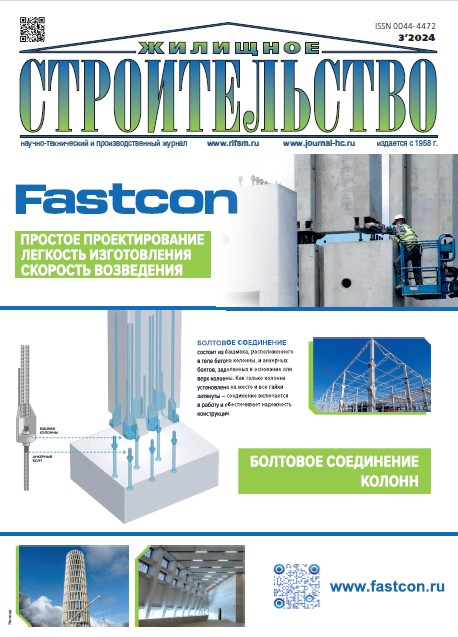Модернизация зданий первых массовых серий
- Авторы: Горшков А.С.1, Войлоков И.А.2, Орлович Р.Б.3
-
Учреждения:
- Санкт-Петербургский государственный университет промышленных технологий и дизайна
- Санкт-Петербургский государственный архитектурно-строительный университет
- ООО «ПИ Геореконструкция»
- Выпуск: № 3 (2024)
- Страницы: 26-34
- Раздел: СТАТЬИ
- URL: https://rjdentistry.com/0044-4472/article/view/635699
- DOI: https://doi.org/10.31659/0044-4472-2024-3-26-34
- ID: 635699
Цитировать
Полный текст
Аннотация
Исследование посвящено вопросам модернизации жилых многоквартирных зданий первых массовых серий. Приведены объемы построенного в советское время жилья. Показано, что по мере насыщения строительного рынка в строительной отрасли акцент постепенно должен сместиться от нового строительства в сторону реконструкции существующего жилья. С этой целью уже сегодня следует разработать комплексную программу модернизации жилых кварталов, застроенных зданиями первых массовых серий. Показан пример реализации подробной программы за рубежом и опыт модернизации панельных зданий в России. Приведены конкретные мероприятия, которые могут быть реализованы в рамках такой программы. К их числу можно отнести: объединение соседних квартир с целью увеличения площади и улучшения функциональности помещений; надстройку дополнительных этажей; пристройку к существующим зданиям дополнительных лоджий, балконов и террас; перестройку здания с целью изменения его объемно-планировочного решения; изменение архитектурного облика здания путем художественного оформления фасадов с одновременным повышением уровня комфорта помещений, повышением звуко-, пожаро и теплоизоляционных функций здания. Также в работе описаны риски реализации таких проектов и показаны источники их финансирования.
Полный текст
Об авторах
А. С. Горшков
Санкт-Петербургский государственный университет промышленных технологий и дизайна
Автор, ответственный за переписку.
Email: alsgor@yandex.ru
д-р техн. наук, профессор кафедры интеллектуальных систем и защиты информации
Россия, 191186, г. Санкт-Петербург, ул. Большая Морская, 18И. А. Войлоков
Санкт-Петербургский государственный архитектурно-строительный университет
Email: voilokov@mail.ru
канд. техн. наук, доцент кафедры организации строительства
Россия, 190005, г. Санкт-Петербург, ул. 2-я Красноармейская, 4Р. Б. Орлович
ООО «ПИ Геореконструкция»
Email: orlowicz@mail.ru
д-р техн. наук, проф., науч. консультант
Россия, 190005, г. Санкт-Петербург, Измайловский пр., 4Список литературы
- Прокофьева И.А. Хрущевки – снос или реконструкция: современные тенденции // Жилищное строительство. 2015. № 4. С. 43–46.
- Лебедева Е.Н. Подходы к преобразованию жилой среды «Серого пояса» Санкт-Петербурга с учетом пандемии // Инженерно-строительный вестник Прикаспия. 2021. № 1 (35). С. 57–65.
- Вишнивецкая А.И., Коршунова Е.М., Коршунов А.Ф. Совершенствование механизма реновации территорий типовой жилой застройки в Санкт-Петербурге // Вестник гражданских инженеров. 2019. № 3 (74). С. 209–215. doi: 10.23968/1999-5571-2019-16-3-209-215
- Коршунова Е.М., Вишнивецкая А.И. Современные проблемы развития застроенных территорий // Вестник гражданских инженеров. 2018. № 2 (67). С. 258–263.
- Варламов А.А., Римшин В.И., Тверской С.Ю., Чикота С.И. Новаторский опыт крупнопанельного домостроения в Магнитогорске // Строительство и реконструкция. 2019. № 3 (83). С. 63–71. doi: 10.33979/2073-7416-2019-83-3-63-71
- Вишнивецкая А.И., Коршунова Е.М. Обеспечение комплексности при реновации застроенных территорий // Вестник гражданских инженеров. 2018. № 6 (71). С. 214–220. doi: 10.23968/1999-5571-2018-15-6-214-220
- Соколов Н.С. Технология усиления основания фундаментов в стесненных условиях при надстройке четырех дополнительных этажей // Строительные материалы. 2018. № 7. С. 31–36. doi: 10.31659/0585-430Х-2018-761-7-31-36
- Соколов Н.С. Технология увеличения несущей способности основания // Строительные мате-
- риалы. 2019. № 6. С. 67–71. DOI: https://doi.org/10.31659/0585-430X-2019-771-6-67-71
- Соколов Н.С., Соколов С.Н., Соколов А.Н., Федоров П.Ю. Использование буроинъекционных свай ЭРТ в качестве оснований фундаментов повышенной несущей способности // Промышленное и гражданское строительство. 2017. № 9. С. 66–70.
- Гончаров Ю.А., Дубровина Г.Г. Достижение эргономичности в архитектуре за счет применения декора фасадного на основе минеральной ваты // Строительные материалы. 2019. № 3. С. 14–18. DOI: https://doi.org/10.31659/0585-430X-2019-768-3-14-18
- Горшков А.С., Кабанов М.С., Юферев Ю.В. Анализ тепловых нагрузок и удельного потребления тепловой энергии в многоквартирных домах // Теплоэнергетика. 2021. № 8. С. 72–80. doi: 10.1134/S0040363621050052
- Gorshkov A.S., Vatin V.S., Rymkevich P.P. Climate change and the thermal island effect in the million-plus city. Construction of Unique Buildings and Structures. 2020. No. 4 (89), pp. 8902. doi: 10.18720/CUBS.89.2
- Klimenko V.V., Fedotova E.V., Tereshin A.G. Vulnerability of the Russian power industry to the climate change. Energy. 2018. 142, pp. 1010–1022. doi: 10.1016/j.energy.2017.10.069
- Клименко В.В., Клименко А.В., Терешин А.Г., Федотова Е.В. Климатические экстремумы – новый вызов для российских энергосистем // Теплоэнергетика. 2021. № 3. С. 3–17. doi: 10.1134/S004036362103005X
- Мильков Д. А., Юферев Ю. В., Тютюнников А. И., Горшков А. С. Изменение климата и его влияние на инженерно-энергетический комплекс (на примере Санкт-Петербурга) // Теплоэнергетика. 2023. № 3. С. 87–96. doi: 10.56304/S0040363623030049
- Хендрикс А., Волович Н.В. Реновация в Восточной Германии: программа поддержки «исчезающих» городов // Имущественные отношения в Российской Федерации. 2018. № 5 (200). С. 26–42. doi: 10.24411/2072-4098-2018-15002
- Горшков А.С. Модель оценки прогнозируемого срока окупаемости инвестиций в энергосбережение // Вестник МГСУ. 2015. № 12. С. 136–146.
- Цейтин Д.Н., Ватин Н.И., Немова Д.В. и др. Технико-экономическое обоснование утепления фасадов при реновации жилых зданий первых массовых серий // Строительство уникальных зданий и сооружений. 2016. № 1 (40). С. 20–31. doi: 10.18720/CUBS.40.2
Дополнительные файлы
















